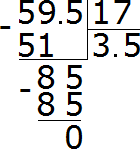To divide a decimal by a decimal, you must move the dot to the right in the dividend and in the divisor to the same number of digits as there are after the dot in the dividend, and then divide by a regular number.
For example, divide 5.95 by 1.7
Write this expression in the corner

Now move the dot to the right in the divident and in the divisor to the same number of digits as there are after the point in the divisor. There is one digit after the dot in the divisor. So we must move the point to the right by one digit in the dividend and divisor. Let's move it:

After moving the point to the right by one digit, the decimal 5.95 became 59.5. And the decimal 1.7, after moving the point to the right by one digit, turned into the regular number 17. And we already know how to divide a decimal by a regular number. Further calculation is not very difficult:

The point is moved to the right in order to facilitate division. This is allowed because when you multiply or dividend a divisor and a divisor by the same number, the quotient does not change. What does this mean?
This is one of the interesting features of division. It is called the property of the quotient. Consider the expression 9 : 3 = 3. If in this expression the divisor and the divisor are multiplied or divided by the same number, the quotient 3 will not change.
Let's multiply the divisor and the divisor by 2, and see what happens:
(9 × 2) : (3 × 2) = 18 : 6 = 3
As you can see from the example, the quotient does not change.
The same thing happens when we move the point in the dividend and divisor. In the previous example, where we divided 5.91 by 1.7, we moved the point one digit to the right in the dividend and divisor. After moving the point, the 5.91 was converted to 59.1, and the 1.7 was converted to 17. What was really happening here was multiplying by 10. This is what it looked like:
5.91 × 10 = 59.1
1,7 × 10 = 17
Therefore, the number of digits after the dot in the dividend determines by how many digits the dividend and divisor will be multiplied. In other words, the number of digits after the dot in the dividend will determine by how many digits in the dividend and in the divisor the dot will be moved to the right.
2. If you find an error or inaccuracy, please describe it.
3. Positive feedback is welcome.